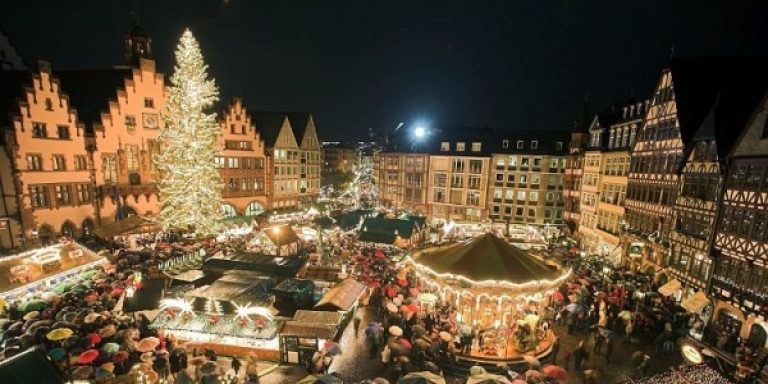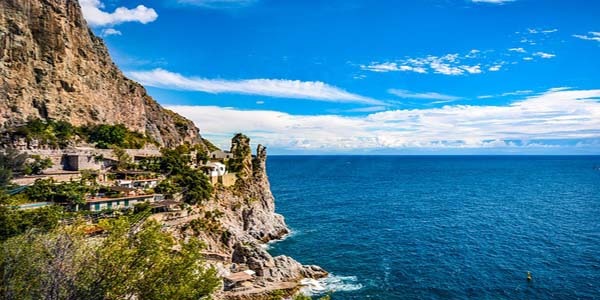There are so many places to visit in Liverpool that this city in the North West of England will give you. Great commercial hub of the country during the Industrial Revolution, in recent years Liverpool has managed to propose itself to tourists and curious visitors from all over the world as the perfect destination for holidays in the name of art and culture.
Whether you are just passing through, or you have a few more days to discover all the attractions of the city, in this little guide we have collected the things to see in Liverpool and the little gems not to be missed. Not only important museums and monuments, but also cafes, bookshops and historic pubs.
Here are all the places to visit in Liverpool and the most interesting things to see in the city of The Beatles and Liverpool FC.
Albert Dock in Liverpool

If you happen to need to show someone how to do a serious redevelopment of an abandoned port, take him by the hand and take him to one of the places to visit in Liverpool – the Albert Dock. For a few decades the old harbour warehouses were the most infamous and dangerous place in the UK, until the local authorities decided it was time to upgrade everything.
Where there were drug dealers and prostitutes today are the Tate Gallery, the most important modern art gallery in Northern Britain, the Beatles Museum which tells the life of the band in Liverpool and the Maritime Museum which tells the merchant history of Liverpool. Obviously the Albert Dock are now a point of reference for tourists and “Liverpudlians” and therefore there are an infinite number of bars, restaurants, pubs and entertainment spaces.
On the Beatles’ trail in Liverpool
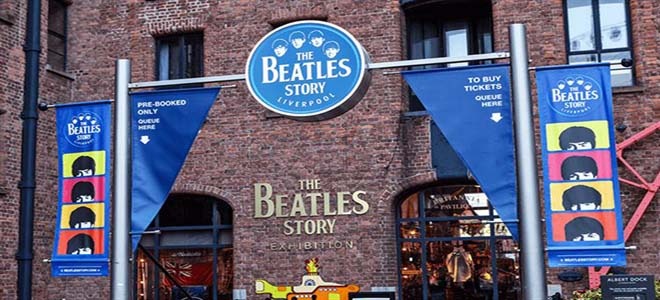
Liverpool and The Beatles are an inseparable pair and the English city has found a way to make it one of its most important tourist attractions. The journey through the life of the “Fab Four” starts from “The Beatles Story”, a museum that tells the story of the 4 boys of Liverpool with photos, memorabilia, clothes, musical instruments, including the piano with which Lennon wrote “Imagine”.
Even more exciting, if possible, a 3-hour tour in a classic black taxi around the places associated with The Beatles. When you visit this place in Liverpool you will pass by Penny lane, Strawberry Fields park and the houses that hosted the childhoods of George, John, Paul and Ringo. Obviously could not miss a yellow submarine, made in the image of the famous song, now located at the exit of Liverpool airport. If you want to take a tour of the places, but save money, there is the Magical Mistery Tour by bus. It leaves from the Albert Docks and at a cost of £12 it does more or less the same tour as the taxi.
Tate Liverpool
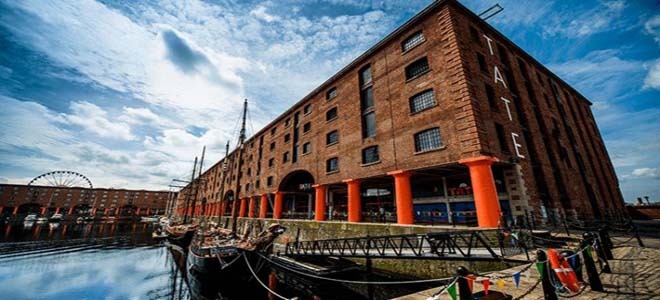
Tate Liverpool is not a real independent art gallery because in essence it lives on loans from London’s most famous Tate. It is not easy to predict what will host the gallery when you visit it, because there are no fixed works but rotate those hosted in the capital.
Modern and contemporary art is queen, with particular regard to the greatest artists of the twentieth century such as Modigliani, De Chirico, Picasso, Boccioni, Pollock, Warhol, Duchamp, Chagall, Klee, and the movements to which they belonged: Surrealism, Pop Art, Minimalism, Abstract Expressionism, Conceptual Art. Admission is free, so it’s always worth going for a ride to see what’s on display!
Read also: Stairs in the woods
Liverpool’s two cathedrals
Liverpool’s two cathedrals could not be more different, even symbolically located at either end of Hope Street. The great Anglican Cathedral of worship is considered one of the most beautiful churches in the world. Designed by Giles Gilbert Scott (the same as the red phone booth), at first glance it would appear to be a few centuries old, but it is just over 100 years old.
Construction began in 1901 and was only completed in 2008, at the same time as the other cathedral, the Catholic cathedral dedicated to Christ the King. Looking at the latter, one might think that the Protestant architect who designed it wanted to rage against the “rival cult”. On the outside it is similar to a disco, a spaceship or a nuclear power station, even if inside the play of colours of the stained-glass windows makes one forgive the ugliness of the outside. The circular and pointed shape of the upper part is inspired by the crown of thorns of Christ.
The Walker Gallery in Liverpool

The Walker Gallery is one of the most important art galleries in the UK and definitely one of the places to visit in Liverpool. You wouldn’t expect to find such a beautiful collection in a city like Liverpool, but Sir Andrew Barclay Walker was rich and loved his city. The works in the gallery cover the centuries from the Middle Ages to the present day, with a rich section dedicated to contemporary art. Do not miss the Italian paintings (Simone Martini, Titian, Perugino, Rosso Fiorentino) some important foreign works, including a self-portrait by Rembrandt and paintings by Degas, Cezanne, Poussin, Monet, Rubens, Murillo.
Among the works of 1600 there is also a sculpture by Bansky (Cardinal Peccato), a reproduction of the bust of a cardinal with a “pixellated” face, a work that the English graffiti artist used as a complaint against the scandal of paedophilia in the English church. The museum is famous for its large collection of works by Pre-Raphaelites, an artistic movement born in England in the late 1800s. The name is not a tribute to Raphael but indicates the desire to return to painting before the Italian master, accused of having polluted art by idealizing nature and sacrificing reality in the name of beauty.
The Three Graces of Liverpool
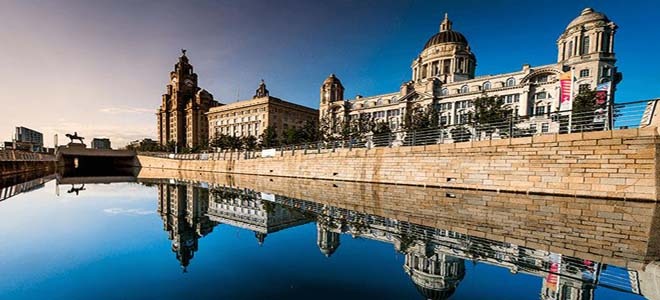
The palaces of the Royal Liver Building, the Cunard Building and the Port of Liverpool Building are called “The Three Graces” by Liverpool residents. The Royal Liver Building is the one with the twin towers and clocks: built at the beginning of the 1900’s mixing Baroque, Modernism and Byzantine style, it was for a short time the tallest building in Europe. On the two towers are the Liver Birds, the symbol birds of Liverpool.
Legend has it that if one day the two statues fall, Liverpool will fall too. Next to it is the Cunard Building, built between 1914 and 1918 to house the headquarters of the Cunard Shipping Company. It has an elongated outer shape at the back (in the shape of a bow), and the interior furnishings (wood, Corinthian capitals) are reminiscent of those of a ship. The third grace is the Port Palace of Liverpool, built in the same years as the previous ones with the evident aim of magnifying the maritime power of Great Britain.
Crosby Beach and the statues of Gormley
We know that hardly anyone visits Liverpool to go for a walk on the beach, but Crosby Beach is not a beach like the others. Here the English artist Antony Gormley has created his artistic installation: 100 iron statues reproducing the artist’s body, spread over 2 kilometres of beach and totally at the mercy of the weather.
Almost entirely covered in sand, with their legs in the water or with rusty iron, Gormley’s statues are a disturbing presence, especially in winter, when there aren’t many people on the beach. The meaning of the work is in the name chosen by the artist for this installation: “Another Place, another place”. It is a work about the drama of emigration, about the reasons that lead people to look for a new hope somewhere else.
The Maritime Museum of Liverpool

“If Liverpool has long been one of the richest cities in the world, it owes it to the sea and its shipyards.”
A history that today lives again in the Maritime Museum of Liverpool, a journey to discover the relationship between the English city and the sea. It tells the story of the transatlantic liners built in Liverpool, the emigration to America that passed largely from here, the role played during the Second World War, and also the tribute paid to the sinking of the Titanic: an important part of the crew who died during the tragedy came from Liverpool.
Museum of Liverpool
The Museum of Liverpool opened its doors in July 2011, offering the many curisos and tourists visiting the city a taste of Liverpool’s extraordinary merchant history and the vicissitudes and developments of its famous port. Its iconic architecture, the result of joint work between Danish and local designers, has earned the Museum of Liverpool several awards.
If you want to learn more about England and the city’s history, this museum is for you. Admission is free. They are part of the National Museums of Liverpool and the Walker Art Gallery and Lady Lever Art Gallery are also worth a visit. It is one of the best places to visit in Liverpool, so if you have time, make the most of it!
The Statue of the Beatles
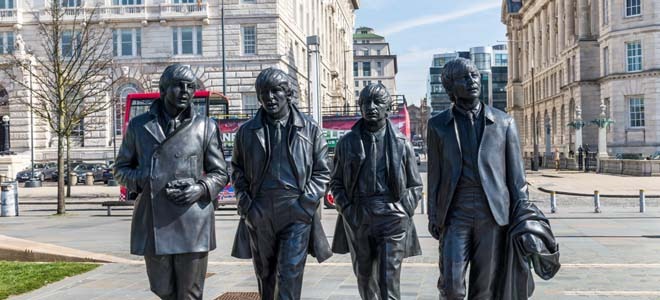
You can’t visit the best places in Liverpool without taking a selfie with the Fab Four! The 4 Statues of the Beatles, made by Andrew Edwards and much loved by tourists visiting the city, were installed along Liverpool’s waterfront (just opposite the Mersey Ferries Building) in 2015. Definitely at the top of Liverpool’s list of things to see!
Liver Building
Not far from the well-known Beatles Statues, along Pier Head, you’ll have no trouble noticing the beautiful Royal Liver Building, one of the 4 tallest buildings in the city and a wonderful example of early 20th century architecture. Iconic are the two towers with clocks (George clocks), topped by the Liver bird, the symbol bird of Liverpool and flanking the imposing structure of the building, once owned by the Royal Liver Assurance and now home to several companies.
Cavern Club

One of the things to see in Liverpool that we really recommend you don’t miss is a live show at the Cavern Club, the historic venue where the Beatles have been performing for many years and where they actually started to take their first steps into the world of music. Since the 50s of the last century, at number 10 Mathew street, it is in this small underground lair that the history of world music has passed. Most of the time, admission is free and shows start at 11:15 pm every night. Take a look at the site to keep up to date with the performances and artists on the programme and pop in to immerse yourself in the historic atmosphere of super trendy England in the 1960s.
Kazimier Garden
If you are looking for a place in Liverpool for a drink or an aperitif in an informal and pleasant atmosphere, stop by Kazimier Garden. A botanical garden terrace with live music, craft beer and friendly staff who will be happy to give you a few hours of fun.
Bold Street
If you have time for a bit of shopping and feel like strolling through colourful shop windows, cafes and small galleries of local artists, there is no doubt that you should stop in Bold Street. Vintage shops, bookstores, small cafes, designer studios and small restaurants of international cuisine (here you will find from Sushi to Peruvian cuisine) make Bold Street the perfect place for a pleasant walk, maybe looking for a souvenir to take home.
Reid of Liverpool
Not far from the lively Bold street, at 105 Mount Pleasant, you’ll find the small antique bookshop Reid of Liverpool, which will tempt you with its dusty volumes and wonderful colours to stop by for a visit. This little gem is housed in the city’s last original Georgian habitable building, built in 1785, so it’s really worth a stop!
St. Luke’s bombed out Church
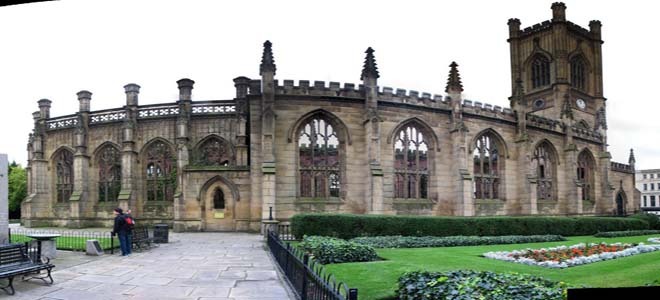
St Luke’s Church in Liverpool, built in the early decades of the 19th century, is also known as “Bombed out Church”, as it was left homeless after the German bombings during the Second World War (Liverpool Blitz). Since 1941, the Church has remained the perimeter structure, but it was never intended to repair the roof, wanting to keep the Church in this state as a symbol, and in honor, of all those who fell during the war.
Liverpool Cathedral, St. James’s Mount
One of the places to visit in Liverpool is certainly its beautiful neo-Gothic Cathedral (Cathedral Church of Christ in Liverpool), one of the 10 largest cathedrals in the world and, in fact, the largest in the UK.
The Cathedral Tower, over 100 metres high, would be one of the largest towers in the world, with one of the largest (and heaviest) bell complexes in operation today. The visit to the Cathedral is free of charge (although a small donation of 5 euros is suggested) and can be made every day, from 8:00 to 18:00 (opening hours of the Church), unless otherwise specified for special rites and functions.
The Liver Bird murals
If you are a street art lover or if you just want to take home a particular selfie, among the places to visit in Liverpool there is also this famous mural. Jamaica street is teeming with little graffiti, murals and colourful gems by local artists (and some swear there’s even a Banksy!). Paul Curtis’ mural, however, immediately entered the heart of Liverpool’s inhabitants and many tourists who come here to take a souvenir photo. How can we blame him!
The Brunch Club
If you’re in the UK and visit Liverpool, you can’t help but treat yourself to a delicious brunch and linger among the many delicacies with which small bakeries, bakeries and neighborhood cafes will spoil you. If you’re in Liverpool and have time for brunch, The Brunch Club is the perfect address for you. The name of the place is already on the agenda, so you can choose between a pancake breakfast or brunch with creamy eggs and avocado toast.


